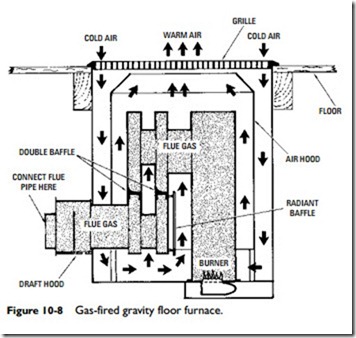Pipeless Floor and Wall Furnaces
A pipeless furnace (Figure 10-8) is commonly a gravity warm-air furnace installed in a central location beneath the floor. A single grille for the warm air and a return is provided for air circulation. This type of pipeless furnace is sometimes referred to as a floor fur- nace, although the latter is actually a permanently installed room heater and should be distinguished as such. Wall furnaces also belong to this category.
Both gas- and oil-fired furnaces are manufactured for installation in recesses cut from the floor. They are available in a wide range of Btu ratings for different types of installations. Some are thermostatically equipped for automatic temperature control and with blowers for forced-air circulation (although those that operate on the gravity principle of air circulation are more common). There
is also a choice between electric ignition and pilot flame. All gas- or oil-fired floor furnaces must be vented.
Another type of pipeless furnace is the gas- or oil-fired vertical furnace installed in a closet or a wall recess. The counterflow types discharge the warm air from grilles located at the bottom of the furnace, as shown in Figure 10-9.
Duct Furnaces
A duct furnace (Figure 10-10) is a unit heater designed for installa- tion in a duct system where a blower (or blowers) is used to circu- late the air. It is commonly designed to operate on natural or propane gas, although electric duct heaters are also available (see Chapter 7 of Volume 2).
Geothermal Furnaces
Calling this heating appliance a furnace is a bit of a misnomer. A geothermal furnace is actually a heat pump, not a furnace. It is designed to use water instead of air to deliver the heat. Geothermal
furnaces are described in Chapter 12, “Heat Pumps” in Volume 3 of the Heating, Ventilating, and Air Conditioning Library.

